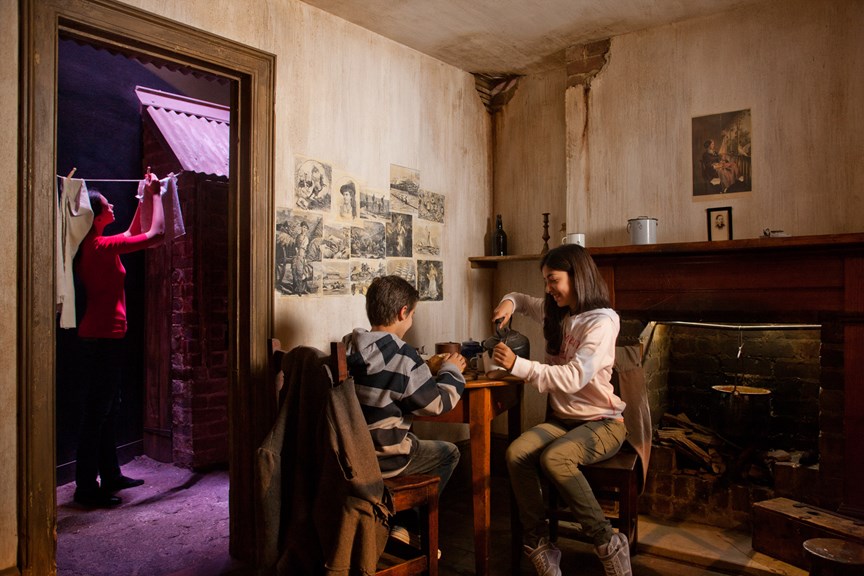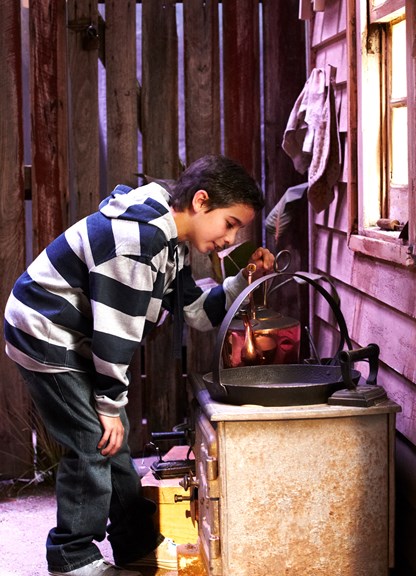2. What will visitors see, feel, taste, hear and smell?
Exhibits, exhibitions and experiences have a superpower: they can use all the senses to help share stories with visitors.
Reflection
The Little Lon exhibit in the Melbourne Story exhibition recreates two cottages from 1880s Melbourne. When visitors explore the cottages, they:
- See what the cottages, furniture and decorations looked like, and read information;
- Hear the voices of people who lived in the cottages describing their lives, and children playing outside;
- Touch the materials in the cottages, sit on the furniture, and compare comfort in the different environments; and
- Smell the fireplaces, laundry soaps and horse manure of 1880s ‘Smellbourne’.
There’s only one sense Little Lon doesn’t use—visitors are not encouraged to taste this exhibit!
- Have you visited the Little Lon exhibit?
- Write down anything else you remember from the experience.
Inspiration
Smells and scents can be powerful tools for evoking memories and emotions. Look at these descriptions of how two museums have used smells in different ways.
The Smell Trolley at Melbourne Museum
Smells and memories
Why does a certain smell bring back memories or feelings?
Our sense of smell, processed by the olfactory bulb, is situated close to the areas of the brain that are linked with emotion and memory.
Melbourne Museum has a ‘smells’ touch trolley which has been developed as part of the Mind Gallery. The trolley, with a suite of different ‘smells’ offers a unique way to for visitors to engage and talk with museum staff.
What is this smell? What does it make you think of? These are some of the questions posed to stimulate conversation and memory.
On offer are two types of smells. Jasmine, lemon, orange, coffee, shoe polish and spearmint are amongst the International smells. Australian smells include Velvet soap, Eucalyptus oil, baby talc and Vegemite.
Some smells are impossible to capture in a bottle such as the smell of the earth after days of heat when the rain first falls. One company has tried to make these smells, and a small selection of these has been added to the trolley - visitors can try ‘birthday cake’, ‘cut grass’ and ‘earth’.
The strongest memories of childhood are the perfumes or skin creams of parents. Nivea cream, Old Spice cologne, Brut cologne and 4711 Ice cologne have also been included on the trolley!
Other smells are generational. People remember different smells of their childhood depending on their age, and of course the environment around them when they were growing up. Older people may remember muddy earth smells, orchards and fresh air. What will young people today remember later?
The Scents Of Monet’s Famous Garden At Denver Art Museum
The Denver Art Museum worked with a professional perfumer to use fragrance to transport people to the famous Impressionist painter Claude Monet's garden at Giverny in northern France.
Your sensory experiences
- Draw four lines on a piece of paper to create five columns.
- In each column, write the name of a sense (sight, sound, smell, touch, taste).
- Think about your visitor and your story.
- In each column, list at least one idea for how that sense could help your visitor learn or feel something about your story. For example: smelling eucalyptus could help my visitor feel like they’re in my garden. A drawing of the tree could help my visitor understand how tall it is. My visitor could learn more about the cake I baked by tasting icing. Upbeat music could help the visitor understand how I felt. A video could show how I stirred the cake mixture.
- Choose at least one idea to include in your exhibit, and plan what you might need for it. For example: to play the video, I’ll need to set up my iPad inside the exhibit.

